#4 NW Front Street
Coupeville, Washington
Robertson Store / Butcher / Sedge Building / Knead and Feed / Little Red Hen Bakery / Molka Xete
1866 - John Robertson built the store. An early sketch map shows it to have been a dryer.
Quote from "A Particular Friend, PENN'S COVE" by Jimmie Jean Cook
John Robertson's store was built in 1866, the first reference to it is contained in a mortgage from John to his father, Captain William Robertson, and refers to the piece of land purchased from Frances Fay together with store, warehouse and dwelling house. The witnesses were Captains Lovejoy and Kinney.
1871 - John Robertson leased the store to P.W. McClure as a butcher shop.
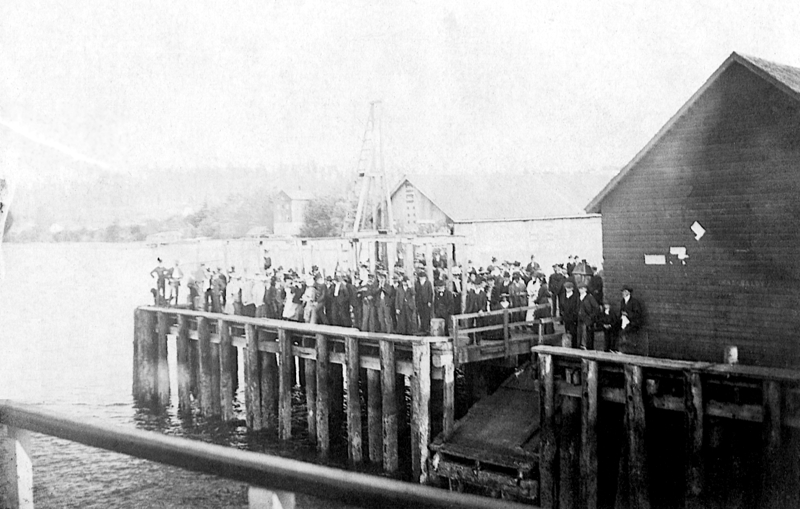
Sedge Building standing alone in background as seen from a vessel docking at the Robertson Wharf . This picture must have been taken between 1883 and 1890
Courtesy: Island County Historical Museum, Coupeville

Robertson's Wharf with one of the ferries. Note that the Sedge building stands alone on the right so this picture must have been taken between 1883 and 1890
Courtesy: Island County Historical Museum, Coupeville
Quote from "A Particular Friend - PENN'S COVE" by Jimmie Jean Cook.
SEDGE OR BLOCKSEDGE BUILDING
On April 4, 1871, John Robertson leased to a P. W. McClure the building on the northeast corner of the A. L. Alexander claim known as the butcher shop, being one room on the upper floor. The lease ran for one year at the rate of $8 per month.
The next recorded transaction on this property is made in 1890 when Robertson and his wife sold the building to A. J. Sedge. The San de Fucan in its one edition said, "Mr. A. J. Sedge is the undertaker for Coupeville. There is very little use for his services in that line on account of the healthfulness of the city, and he carries a fine stock of furniture, wall paper, window shades, etc., which he sells in his spare time. He has a good stock of goods and a handsome store."
According to Kellog who received the information from Charles Angel, editor of the Sun, Sedge had come to this community and opened a cabinet shop in 1888. He brought with him a wife and three children. In 1890 Mrs. Sedge died and a sister, Mrs. Blocksedge, came to Coupeville to help him close out his business.
Eventually the news came that Sedge was an errant husband, John Blocksedge, who had deserted his wife in the midwest, leaving with a young girl from his hometown. Now she was dead and the wife was called upon to help him.
The records verify the dilemma this man was in. He had received the deed as Sedge and in April 1891 sold the property to Harold Pelkington using that name. On the same date Pelkington sold it back to John J. Blocksedge. Either he was helping the man clear the title or else he wanted no part of the business. Blocksedge then gave power of attorney to John Seymour to dispose of the building but no further action was taken until 1903.
In September, two deeds, one from C. E. Blocksedge, wife of John J. Blocksedge, notarized in Shoshone Co., Idaho; the other from John acknowledged at Leavenworth, Washington, were given to Tasmin Race, brother of Puget who was running the drugstore next door. So we leave the Blocksedges, still married but living comfortably apart, knowing that distance will make the heart grow fonder.
The list of subscribers for the publication of the Sun which was filed with the county auditor in 1893 includes the name of J. J. Blocksedge, a personal joke with Mr. Angel who seems to have enjoyed the situation.
A bed showed up in the Glenwood hotel recently with the name A. J. Sedge written across the back of the headboard. He was leaving town just as the hotel was being established, and apparently Chris Fisher purchased furniture from this Victorian lovenest.
The building's east wall is directly on the line between the Coupe and Alexander donation claims. The front windows were made and fitted by Blocksedge.
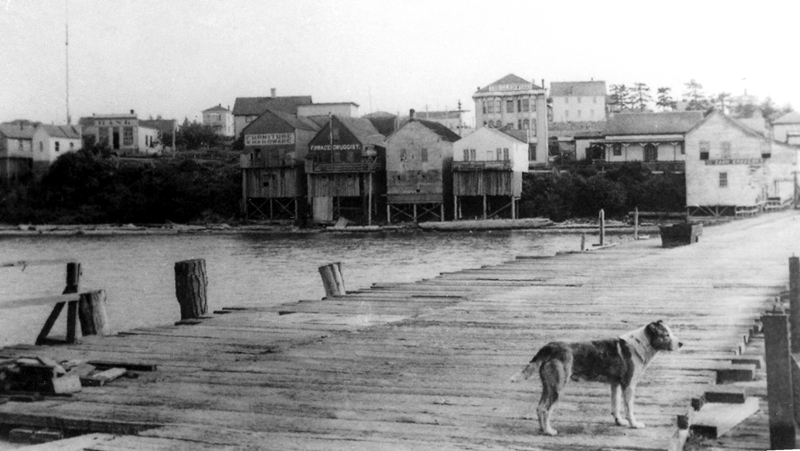
From Robinsons Wharf
The four buildings on stilts on the beach were; The Furniture Warehouse, the Race Druggist, the Sedge Building, and the Library/Town Hall. The first and fourth of these no longer exist.
Courtesy: Island County Historical Museum, Coupeville
1890 - The building was sold to A.J. Sedge, an undertaker. He also dealt in furniture, wallpaper, window shades, etc.
Later his wife, Mrs. Blocksedge, came to help him close the business. There was also a Chinese laundry in the lower level. Recently Chinese characters have been found in the building.
1903 - The building was deeded to Tasmin Race, the brother of Puget Race who ran the druggist business in #2 Front Street.
In the early 1920s a telephone office was in enclosed in the space between #2 and #4 Front Street. In the late 20s it was moved to to a new building at Main and Coveland but the enclosed space remained and is still there.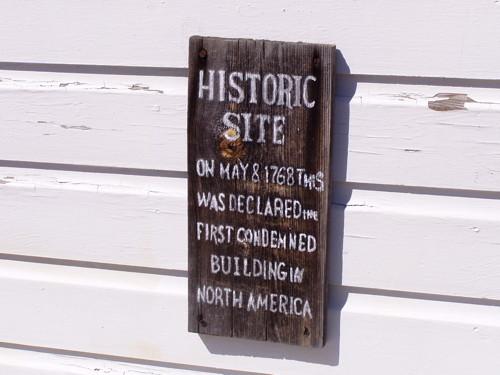
Early in the third millennium this sign was on the enclosure between #2 and #4 - it may not be accurate!
Courtesy: Robert Y Elphick, 2006
In the 1940's - Mr. Francis ran a drug store in the building after the closure of the Drug store in #2.
*From an interview by Judy Lynn with Carol Thrailkill in 2009
Mr. and Mrs. Francis lived in what was the Old Town Shop. They had the drug store in the ‘40s. in what is now the Knead and Feed (originally the Sedge Building.) There was a long counter on the right. He would come through the door on the other side.
*From an interview by Judy Lynn with Pat Sullivan in 2009
Mr. Francis had a drug store in the Knead and Feed (Sedge building). I remember Elmer Calhoun. He was an old man then but he was always out there to improve the property. He didn’t get much done but was always out there trying. I remember Bill Engle working for Fred Moore, owner of the hardware store in the Calhoun Apartment (Glenwood Hotel) building.
*From an interview by Judy Lynn with Larry Zylstra in 2010
Larry: Mrs. Frances had a pharmacy in the building the Knead and Feed is in now. She was a sweet little lady - she gave me candy bars. She was little and fragile. In the early days there was a Mr. Frances and they ran it together. When I started getting her mail for her I was still in grade school - probably 12 years old. Albert Bowers, a year older and 100 pounds heavier, would stop twice a week. He would go below where she lived and cut kindling for her. Their pharmacy followed the Race Drug Store because the Frances Drug Store was the only one on Front Street.
1969 - Betty Beckwith opened the Driftwood Styling Salon. An English teacher may have lived in an apartment in the building at this time.
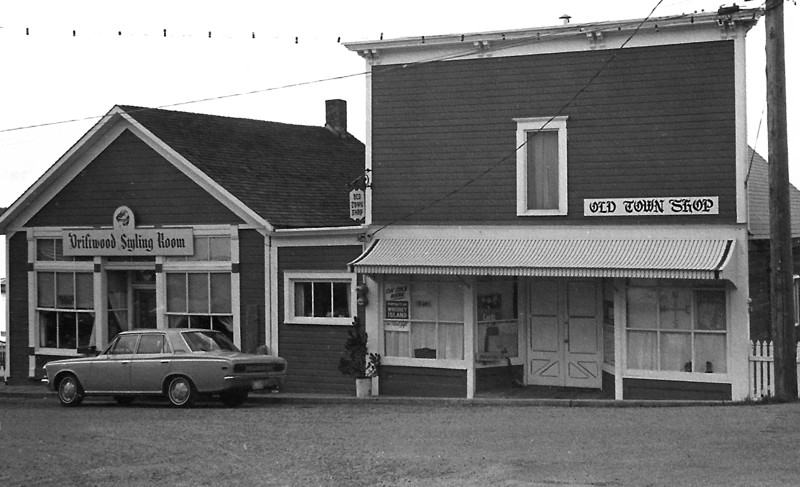
Driftwood Styling Salon
*From an interview by Judy Lynn with Ellie Taylor in 2010
We came to Whidbey Island in 1971 and were in military housing six months. Then we bought five acres on Jacobs Road and put a doublewide on it. When we were still in Navy housing I saw in the paper about a job. Betty Beckwith owned Driftwood Salon on Front Street. (It was located in the Sedge Building.) She gave me a job right away. I wasn’t skinny and I didn’t wear hot pants so I wouldn’t have been hired to work at Jerry’s or Dan’s in Oak Harbor. I had been a cosmetologist since 1954.
In the early 1970s This 'n That was opened by Ardell Kuchenbecker on the street level.
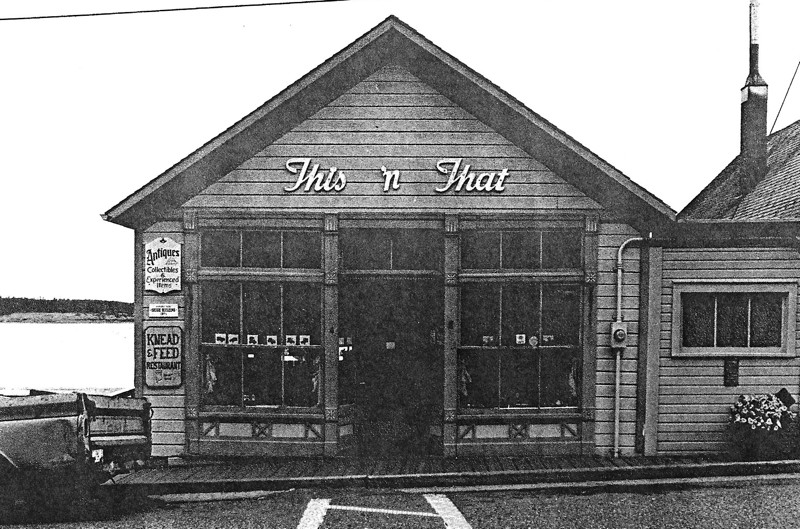
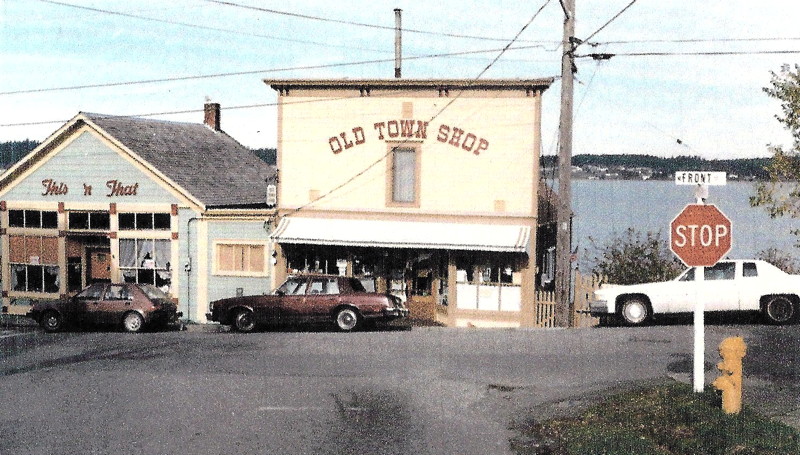
This 'n That - note the sign about the condemned building is just visible on the color picture
*From an interview by Judy Lynn with Lee Anderst in 2008
Ardell Kuckhenbecker [and Chris Hoogerwerf] owned the This N That Shop. Ardell was also our neighbor on Rhodena. She had a little cabin on her lot. She donated the lot to the Seattle Audubon Society and we bought it from them. She lived in Seattle when she had the This N That and it was a week-end shop….it wasn’t open often. I bet she was there for coffee on Thursday’s. She was a companion for Bill McGill. We bought our first property from Bill McGill. Ardell was McGill’s “widow repellant.”
1975 - Knead & Feed was opened on the lower level.
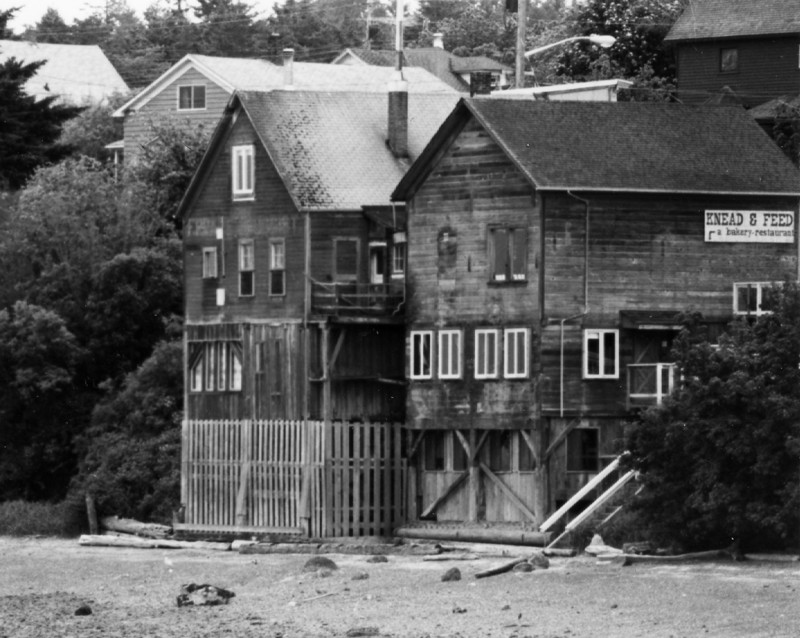
Tartan and Tweeds with Knead & Feed below it
Courtesy: Island County Historical Museum, Coupeville
1977 - The Kroons bought the building from Holace Perry and Mickey Becker. They then moved the baking from 2nd level to 3rd at the beach - it could only be reached at low tide because there was no stairs between the 2nd and 3rd level.
1977 - The lower level of Knead & Feed was remodeled, a porch was added and the 3rd and 2nd levels were connected.
1986 - Ardell Kuchenbecker closed This 'N That and Bickerstaff & Coldicott opened a paper arts business on the street level.
1987 - Tartans and Tweeds, owned by Carol Antmann and Katie Zimmerman moved from across the street (#5 Front Street)
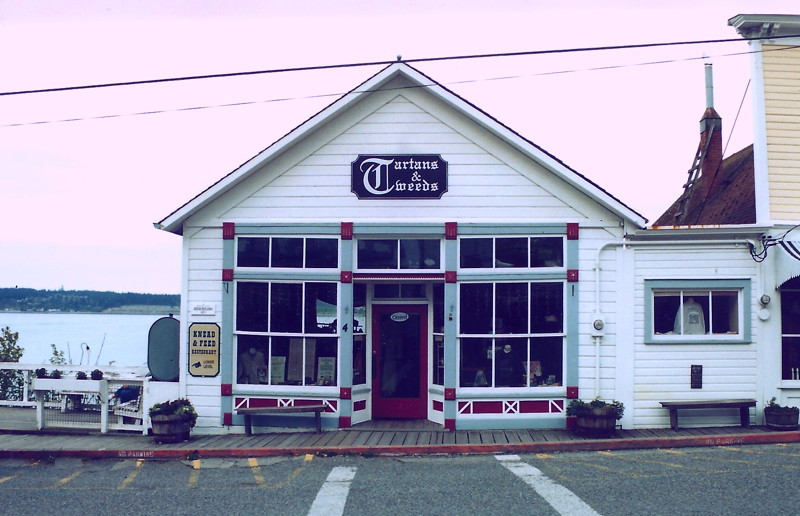
Tartan and Tweeds
Courtesy: Island County Historical Museum, Coupeville
2000 - Katie Zimmerman retired from Tartans and Tweeds
2003 - Tartans and Tweeds closed
2004 - Kitchen shop and espresso opened on the upper floor by the Kroons. It was still called Knead and Feed.
2008 - Knead & Feed kitchen shop & espresso bar was added to the street level.
2009 - The Kitchen Pantry was moved to Coveland. Jeanette Kroon sold interest in Knead and Feed to Doug, Thom and Jerry Kroon.
2010 - Knead and feed restaurant was opened on the street level. Some baking was done here but the main baking remains downstairs.
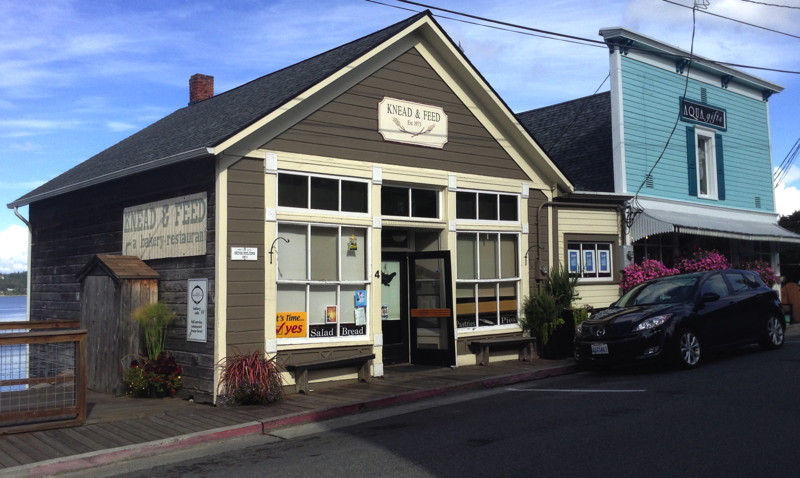
Knead & Feed
Courtesy: Robert Y Elphick, 2013
*From an interview by Judy Lynn with Joan Wieringa in 2009
I remember the Knead and Feed (Sedge Building) with Iris and Mel Kroon and their children helping. They always had the best cinnamon rolls. Julie recalls the smell of baking cinnamon rolls wafting out of the bakery. All bread and pastries were prepared on site. They were huge and cost a quarter (26 cents with tax). You had to get there early in the day or they were sold out. Doug recalls going early on a Sunday morning to buy the cinnamon rolls when no one was yet up and around
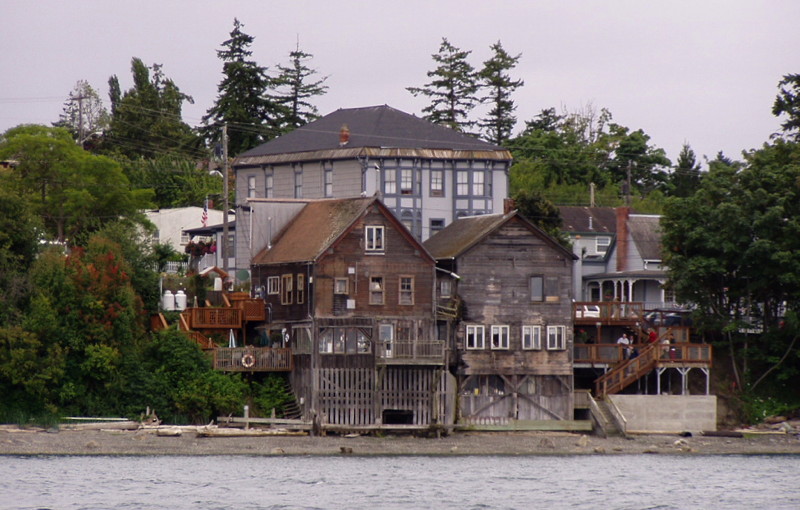
Knead & Feed is the right one of the two on stilts.
Courtesy: Robert Y Elphick, 2005
*From an interview by Judy Lynn with Jeanette Kroon Omar in 2009
Judy: I understand you’ve just sold the Knead and Feed to your brother Doug. Would you please tell me how the business started?
Jeannette: You need money to survive. My brother, Doug Kroon, taught school at Coupeville under a special grant program in the 1970’s and then it ran out. They didn’t have the money to renew. I was in college and Doug researched business ideas. There were no restaurants that did baking and cinnamon rolls. He opened the business in the Mariner’s Cove and was one of the first tenants once the building remodel was finished in 1973.
Randy Duggan had bought the Mariner’s Court building and remodeled it with tiny shops. There was a hallway that went around in a circle. Doug’s place was the second on the left when you went in the main door and it had a Dutch door. That was the Knead and Feed door. It was there until recently. (Willie and Janet Castleton had the first on shop on left, called Knots and Bolts. They sold macramé that Janet made.) He [Doug] started with cinnamon rolls and bread. There were no soup or sandwiches to start.
Then Holace [Perry] and Mickey [Becker – who owned the Old Town Shop on the other end of town] knew that people came to the west end of the street because of the cinnamon roll smell and they wanted the people to go to their shop. They knew people would come up there for the smell. They owned the buildings that their shop was in and Ardell Kuchenbecker rented the top floor for her This N That Shop. We closed Knead and Feed in Mariners Court, did a remodel on lower level below Ardell’s shop. We discovered it had to have been a Chinese laundry. There was calligraphy on the wall and we have some pieces of it framed. Beatrice Powell [who had a gallery on Grace Street] interpreted them. The letters were “Long life and happiness” and “Good luck.” There was no insulation in the building so we put some in. The original wainscoting from the time the building was built by Mr. Robertson is still there. It had open beams that were timbers from the saw mill on East Front Street.
Doug started the business. I was in college at Seattle Pacific University. I would help on weekends and during the summer. My sister, Caroline, would help on weekends when it was in Mariner’s Court.
We got the new place remodeled and rented it from Holace and Mickey. Underneath where the bakery is was our storage area. We had to go down the city stairs to the beach, then back up to the bakery area. When the tide was in we couldn’t get to storage. That changed in 1978. We put on a porch so we could come in directly from the second level. We moved into the new location Doug was still there. Bonnie graduated from college in 1975 or ‘76 and she came in and helped. That’s when we added soup and sandwiches. We did one soup a day and changed every day. Now we have 3 different soups a day. We kept it simple and paid ourselves a minimum amount of money to get it going.
We lived with Mom and Dad [Iris and Mel Kroon] in their home in Captain’s Choice. 1977 was a turning point. Bonnie got engaged and I got a telegram from Afghanistan to come and teach.
Judy: Tell me about that.
Jeannette: I had applied to overseas schools. They were looking for people with teaching experience. I hadn’t heard anything for quite awhile and they sent me a telegraph asking me to teach 3rd and 4th grade. I was thinking I would love to teach 3rd and 4th and here came this telegram. I was single and we didn’t have long term plans. I said yes, Bonnie got married and Doug moved to Seattle. Carolyn had gotten divorced so she moved here and ran the restaurant for 3 or 4 years. That was 1977, ‘78 and most of ‘79.
I taught in a private Christian school in Afghanistan. I was there when the Russians were invading. They killed our ambassadors and the country was under Marshall Law. I couldn’t leave my house at night. It was a pretty intense time. My parents and Carolyn came to visit. We went to Bamiyan and saw the Buddhas that were destroyed. The monks had hand painted the ceilings. The Buddhas had been coated with gold and had jewels for eyes. I remember looking at the mosaic ceiling from on top of their heads. It was a fabulous trip. I met Osman who was a pilot. His family was part of the royal tribe, in a tribal system. His great, great, great grandfather had been the king of Afghanistan. He tried to leave the country because the writing was on the wall. The Russians had killed a distant cousin. Osman was captured and was held prisoner for 7 months by the Russians. When he got out I helped him escape. I had a friend who taking her seniors students on a trip to Pakistan. She also had a friend that needed to get out, a teacher who was married to an Afghanistan man. The Russians were watching my house from an apartment across the street, so we changed my normal schedule, and got Osman out really early in the morning. They hid him and the other man in the back of the school bus. They put both men in tusacks, made out of kalim. Two days layer I moved out of my house and stayed with friends from Sweden.
Osman couldn’t leave Pakistan because he had no passport. I had friends with the British Embassy in Pakistan so I flew to Pakistan. We were married in Pakistan and that’s how he came here. When he got to Seattle airport he was interrogated and that was it. That was July 3, 1979.
We came back here and I substitute taught in Coupeville and Oak Harbor and Carolyn was running the Knead and Feed. Carolyn decided to go back to Seattle and went back to work at NOAH. I took over the restaurant again, where I’ve been from then until now. That’s more than 30 years now.
There were busy times. We changed the layout back in 1993. Tariq was born in 1981 and Shahla was born in 1988. We changed the layout of the restaurant in 1933 when we moved the kitchen, including the ovens and mixer to the basement. When I was gone to Afghanistan they had finished the interior of the lower floor. It had been a shell. They put in a walk-in cooler and put in seating but people didn’t like it there. They wanted to be up on the second level to see cooking and activity. The lowest floor was a waste of floor space so they moved the kitchen to downstairs. Upstairs they put the big table in with the bakery case next to it. It was nice for me because I had more space downstairs for storage. The deliveries were made downstairs.
It was a lot of hard work. My favorite part was the reaction to how big the cinnamon rolls were, how good the food is and that they come back with their grandchildren. I also enjoyed the employees over the years. They were great kids from all the families in town. It was fun to be part of the community and know I employed all these kids. For some it was their first job. It was good to be a mentor, to teach them how to behave and “You need to come to work and show up on time.” I was educated as a teacher and knew to nurture and reward. My former employees bring their kids in.
We bought the building in 1977 from Holace [Perry] and Mickey [Becker.] We also had the little building in between our building and theirs that had been the telephone company. I don’t know how they got the sign on Holace and Mickey’s that theirs had been the Puget Race Drug Store. When we did the remodeling on the street level, there was a cut out with ruby glass into that center section and there was evidence of a pharmacy with prescriptions. They gave the prescriptions out on our side of the building.
(Note: Puget Race Drug Store was in the building that was later owned by Holace and Mickey. Later there was a pharmacy, run by Mr. and Mrs. Frances, in the portion of the building currently owned by the Kroon family.)
There was a building where the town deck is that used to be the city library and town hall. It was torn down by Mayor Ward. He wanted it torn down because the town owned it. When Ted Christianson moved his pharmacy to Main Street he said “Old ladies used to own those buildings” (Holace Perry and Mickey Becker.) Mayor Ward was determined to bulldoze down Front Street. Up until a few years ago, where the town deck is, the library board had control over the deck. The materials for the first deck were donated by the (Arts and Crafts) festival committee. Del Bennett headed up that group. I told Nancy Conard about the library having control of the deck when they were going to do the latest remodel of the deck. I noticed that she had that changed so that the town now has control over the city deck.
Our building was built by Mr Robertson in 1871. He sold it to Mr. Sedge. He originally started with a mortuary but people were too healthy and there was not enough money in the business. Then it became a furniture store. As I mentioned above, I believe that it was a pharmacy for many years. We found old posters advertising mentholated cream and notes for prescriptions when we took down wallboard during our remodel. In the 1960’s it was the Driftwood Styling Salon. An English teacher lived there when it was an apartment and shortly after that Ardell Kuchenbecker and Chris Hoogerwerf came.
The center area that had been the telephone office used to have doors that connected the two sides. There was a deck that went across the water-side of both buildings. When we had to fix the building, Larry Cort noticed there were some odd pieces of wood on the outside and speculated that maybe there had been a pulley system for lifting furniture from a boat.
Judy: Tell me about the Coupeville Arts and Crafts Festival.
Jeannette: It was a busy time. People assume that as a business on Front Street that you make a lot of money during the festival, but as a merchant I can say that’s wrong. It’s difficult to be a merchant. You can’t come in and out and you have to be really well prepared. Now, it’s especially hard as a restaurant. When the food was in the park, it gave the restaurants on Front Street a bit of an advantage. Now that the food booths are in the parking lot, the business on festival days is the same as any other summer day. But I always meet characters and I love the arts and crafts and the Artists in Action. It’s a great time to show off our little town and people are happy. Unfortunately as a business owner, you don’t get the time to go through the festival.
I love the Mussel Festival – that’s a lot of fun. Wharf Fest is new. I have mixed feelings about the Penn Cove Water Festival. I love the canoe races – they’re great and I love the history behind it.
Ardell had the This N That shop on the street level until 1987. Then John Bickerstaff, and his wife Joan, opened Coldecott and Bickerstaff. It was a shop of paper arts. Then Carol Amtmann and Katie Zimmerman moved Tartans and Tweeds to the north side of the street from the John Robertson house (Six Persimmons and now Seaside Spa.)
On April 10th Bonnie and I opened a kitchen shop and espresso bar on the street level. We had wanted to do that for years. We had the upstairs of the building rewired and re-plumbed. Her husband retired from Navy so they lived here. We also sold cinnamon rolls and bread. Bonnie did the buying and managed the inventory.
My niece Marcia Johnson is baking now. She has baked off and on for 10 years, filling in when we needed.
We were at the point of doing something new. I was physically tired of the heavy baking – Marcie married and moved away – so we said “Let’s sell the business.” Doug said “No.” He’s always been in the background but he was a partner and he decided he wanted to keep it in the family. He bought out Bonnie and me. Marcie’s husband transferred back to Whidbey so the timing worked out.
Judy: Tell me about your family. How many siblings are there?
Jeannette: There are 7 of us. Carolyn, Marjorie, Thom, Doug, Jeannette, Bonnie, Jerry. The other two brothers, Tom and Jerry, are silent partners. They helped buy out the building and business. We decided I would keep the espresso and they will keep the rolls. I will maybe do cookies and croissants. They kept the Knead and Feed name. Bonnie and I changed the name of our business to the Kitchen Pantry and moved it to the building I own on Coveland. It was all very amicable. Doug is teaching in Riverside, CA. Marcie is Marjorie’s daughter. Her parents were never partners in the business. From the beginning it was Doug, Bonnie and I. Dad helped remodel the building and his interest was in sweat equity. Doug paid for materials. Dad didn’t want any fighting so he gave his shares of sweat equity to Bonnie and me – equal thirds. [The Kitchen Pantry closed in 2010.]
Judy: So your parents were not owners? I remember them very well at the restaurant.
Jeannette: No they weren’t, but they were very proud of it. Mom loved being the hostess and she regaled people with stories. They were there for coffee every morning and afternoon. Dad loved taking my kids to the Knead and Feed. He really enjoyed that.
Judy: Tell me about the building on Coveland that you own.
Jeannette: I bought it from Darlene Jampsa, after Ken died. It had been Penn Cove Pasta and Pizza. I bought that on my own. I had a 1/3 of the Knead and Feed, was divorced and needed to find a way to support myself. I knew what I wanted it to look like. Dennis Hill suggested that it would make fabulous hotel rooms. I remodeled it into 4 units. It was lot of fun doing it. Each one has a different theme. On the lower floor, Pamela Hill (Dennis’ former wife) has a real estate office. When Ken built the building he had a restaurant on both levels. Then they had antique store there, then Cheyenne Business and then The Stray Dog. After I bought the building there was a thrift store, then Monogram. Bonnie was a partner but now lives in LaConner. The Kitchen Pantry opened April 10, 2009. Bonnie is doing the retail. I am there at least 4 days a week. Bonnie lives in Snohomish and comes one day a week.
Judy: What are the plans for the street level space above Knead and Feed?
Jeannette: Doug is thinking of moving the bakery to the street level and put some tables there. He wants to have food on two levels. The bottom would be office space.
Judy: How does this change feel?
Jeannette: Great. I love it…not to have to get up at 4:00 am and haul 50 lbs of flour around. And I can actually see people. I was always down in the basement. When we were baking and doing sandwiches I was always behind the scenes. I’m a shy person so it’s easier. I’m a behind-the-scene person. I like it. I’m a very quiet person.
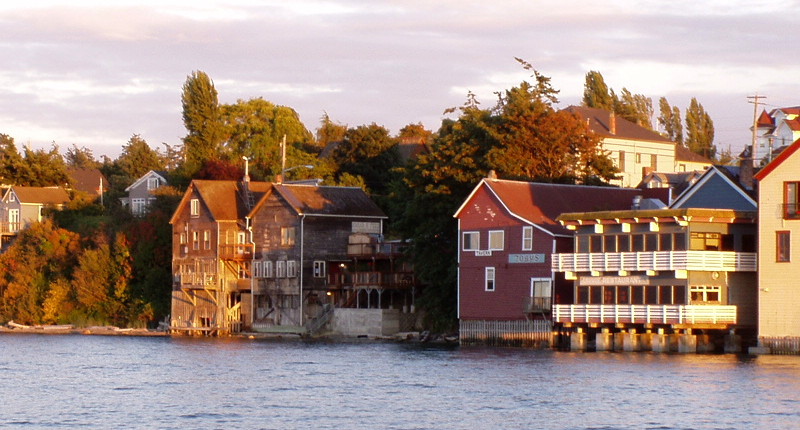
Sunset and High Tide
Courtesy: Robert Y Elphick, 2006
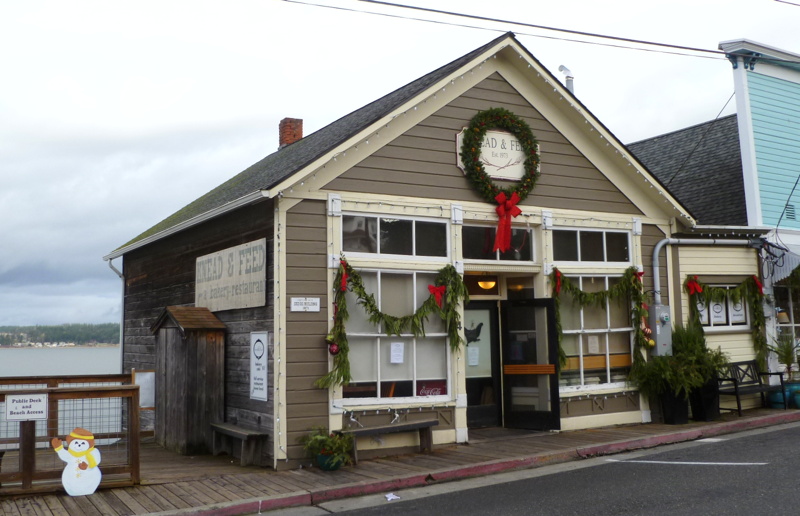
Knead and Feed
Courtesy: Robert Y Elphick, 2015
October, 2019 - Sara and Tyler Hansen (Owners of the Oster Catcher Restaurant on NW Coveland St. at Grace St.) Opened the Little Red Hen Bakery
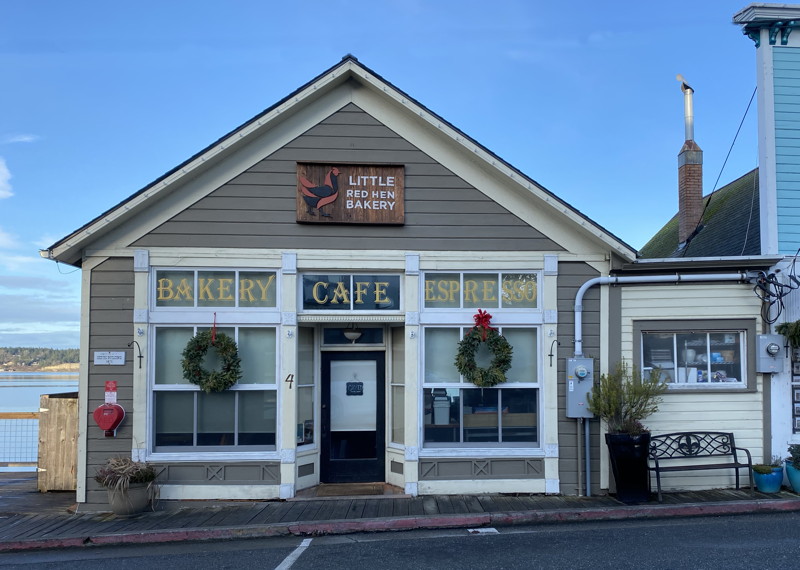
Little Red Hen Bakery
Courtesy: Robert Y Elphick, 2019
2022 - Molka Xete - Mexican Kitchen.
* All the interviews are extracted from the Judy Lynn's Oral History Project. Judy Lynn interviewed everyone she could find who had any memories of the history of Front Street. For more information on the project contact the Whidbey Island Historical Musem, Coupeville.
The e-book Front Street, Coupeville - An Oral History by Judy Lynn contains all the interviews. It can be purchased for $9.99 at Amazon.com for Kindle application or device or from the Apple Store for iBooks applications. Proceeds go to the Island County Historical Society.


